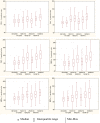Influence of PM1 and PM2.5 on lung function parameters in healthy schoolchildren-a panel study
- PMID: 27628915
- PMCID: PMC5110587
- DOI: 10.1007/s11356-016-7605-1
Influence of PM1 and PM2.5 on lung function parameters in healthy schoolchildren-a panel study
Abstract
To evaluate lung function responses to short-term indoor PM1 and PM2.5 concentrations, we conducted a panel study of healthy schoolchildren aged 13-14 years. The following lung function parameters FVC, FEV1, PEF, and mid expiratory flows MEF25, MEF50, and MEF75 were measured in 141 schoolchildren of the secondary school in Wroclaw, Poland in years 2009-2010. On days when spirometry tests were conducted, simultaneously, PM1 and PM2.5 samples were collected inside the school premises. Information about differentiating factors for children including smoking parents, sex, living close to busy streets, dust, mold, and pollen allergies were collected by means of questionnaires. To account for repeated measurements, the method of generalized estimating equations (GEE) was used. The GEE models for the entire group of children revealed the adverse effects (p < 0.05) of PM1 and PM2.5. Small differences in effects estimates per interquartile range (IQR) of PM1 and PM2.5 on MEF25 (5.1 and 4.8 %), MEF50 (3.7 and 3.9 %), MEF75 (3.5 and 3.6 %) and FEV1 (1.3 and 1.0 %) imply that PM1 was likely the component of PM2.5 that might have a principal health effect on these lung function parameters. However, the reduction of FVC and PEF per IQR for PM2.5 (2.1 and 5.2 %, respectively) was higher than for PM1 (1.0 and 4.4 %, respectively). Adjustment for potential confounders did not change the unadjusted analysis.
Keywords: Children; Indoor PM pollution; Lung function; Panel study; School.
Conflict of interest statement
Compliance with ethical standards Grant support This work was supported by the National Science Centre under the project no. N304 067,937 “Effects of air pollution on short-term pulmonary function changes in schoolchildren”. Competing interest The authors declare that they have no competing interests. Human subjects research This study was approved by the Bioethics Committee of Wroclaw Medical University (nr KB-619/2007, 03.01.2008), additionally the parents of each participant provided informed consent.
Figures


References
MeSH terms
Substances
LinkOut - more resources
Full Text Sources
Other Literature Sources
Medical

